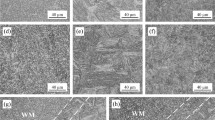Abstract
Advanced creep-resistant steels have been developed to meet the demanding requirements of fossil power plants that strive to improve the generation efficiency by enhancing the steam temperature and pressure. These are ferritic steels with nominal chromium content ranging from 2% to 12% with significant addition of tungsten besides Nb, V, and N in small level. One of the candidate materials is 9Cr-0.5Mo-1.7W steel, developed for steam circuit components of tubes, and pipes of power plants for an operating temperature of 600°C. Hydrogen cracking is a major issue in welding of this steel, due to solid-state metallurgical transformations that lead to untempered martensite in the HAZ of weld joint. The hydrogen cracking does not occur below a threshold stress level called critical cracking stress. The critical stress for cracking in this steel was determined by carrying out implant weldability tests using shielded metal arc welding process for various levels of diffusible hydrogen in the weld metal and an empirical model relating levels of diffusible hydrogen and time taken for cooling from 800°C to 500°C to the critical stress has been developed. Results of current study also showed that residual diffusible hydrogen plays a major role in deciding hydrogen cracking than the initial diffusible hydrogen in the weld metal.
Similar content being viewed by others
References
Masuyama F (2004) Alloy development and material issues with increasing steam temperature. In: Viswanathan R, Gandy D, Coleman K (eds) Advances in materials technology for fusion power plants- Proceedings from Fourth International conference. ASM International, Cleveland
Shibli IA, Robertson DG (2006) 9-12 Cr Martensitic Steels. In: Review of the use of new high strength steels in conventional and HRSG boilers, R&D and plant experience. ETD report: 1045-gsp-40 European Technology Development, Surrey
Campbell WP (1976) Experiences with HAZ cold cracking tests on a C-Mn structural steel. Welding journal 55:135S–143S
Dickinson DW, Tites GD (1979) Implant testing of medium high strength steel. Transactions of Joining and Welding Research Institute Osaka University Japan 59:205S–209S
Evans, Christenson (1973) Correlation of microstructure with HAZ embrittlement. IIW document: IIW-IX-823-73
Inagkin Satoh, Matsui, Ohkuma (1978) Application of implant test for cold cracking. IIW document: IIW-IX-1078-78
ANSI/AWS A4.3 (1993) Standard methods for determination of diffusible hydrogen content of martensitic, bainitic and ferritic steel weld metal produced by arc welding. American Welding Society, Miami
Beres (2001) Welding of martensitic creep resistant steels. Weld J 80:191S–196S
Maridurai, Muthupandi V, Manimozhi S (2006) Studies on HAZ properties of P92 and P91 steels. Thesis report for Master of technology in Welding Engineering. NITT, India
Nevasmaa P (2004) Prevention of weld metal hydrogen cracking in high strength multipass welds. Weld World 48(5/6):2–10
Terasaki T, Hall GT, Pargeter RJ (1991) Cooling time and predictive equation for estimating hydrogen diffusion in CTS test welds. Transac Japan Weld Soc 22(1):52–56
Terasaki T, Kappi R, Satoh K (1979) Relationship between critical stress of HAZ cracking and residual diffusible hydrogen content. Transac Japan Weld Soc 1(1):53–57
Joachim Degenkolbe, Dieter Uwer, Horst Wegman G (1984) Characterization of weld thermal cycles with regard to their effect on the mechanical properties of welded joints by the cooling time t8/5 and its determination. IIW document: IIW-IX-1336-84
Steelmakers from Benelux (1977) Evaluation of cold cracking susceptibility investigation. IIW document: IIW-IX-1031-77
Marshall AW, Zhang Z, Holloway GB (2002) Welding and repair technology for power plants. Fifth International EPRI RRCA conference USA, 1-17
Olson DL, Maroef I, Lensing C (1992) The role of hydrogen trapping in hydrogen management and steel welding. In: National Welding Seminar ’97, India. pp 9–15
Matsuda F, Nakagawa H, Shinozaki K, Kihara H (1978) Effect of oxygen content on diffusible hydrogen in weld metal in inert gas welding for high strength steel. Transactions of JWRI 7(2):135–137
Dilthey U, Trube S (1992) Determination of the diffusion coefficient of hydrogen in steel subjected to deformations and in weld deposits of basic and rutile coated electrodes. J Weld cutting E214:2–5
Author information
Authors and Affiliations
Corresponding author
Rights and permissions
About this article
Cite this article
Manimozhi, S., Suresh, S. & Muthupandi, V. HAZ hydrogen cracking of 9Cr-0.5 Mo-1.7W steels. Int J Adv Manuf Technol 51, 217–223 (2010). https://doi.org/10.1007/s00170-010-2611-9
Received:
Accepted:
Published:
Issue Date:
DOI: https://doi.org/10.1007/s00170-010-2611-9




